Promoting Innovation: Creative Thinking at MatchBox Architects
VerifiedAdded on 2023/06/08
|18
|4534
|151
Report
AI Summary
This report examines the theoretical foundations for promoting individual creative thinking within established organizations, with a focus on developing a plan for MatchBox Architects to foster creativity across all levels. It discusses various models and theories, including the Graham Wallas model, Parnes and Osborn model, multiple intelligence theory, multi-level theory, componential theory, four-factor theory, ambidexterity theory, and design thinking. The report emphasizes the importance of creative thinking in organizations and provides recommendations such as emphasizing leadership's role in handling conflicts through exploitation and exploration, understanding different levels of employee intelligence, utilizing resources, and employing design thinking and creative thinking models to initiate creativity and innovation. It also addresses challenges to creative thinking, such as mental blocks and mindset issues, and suggests structured techniques for problem-solving.
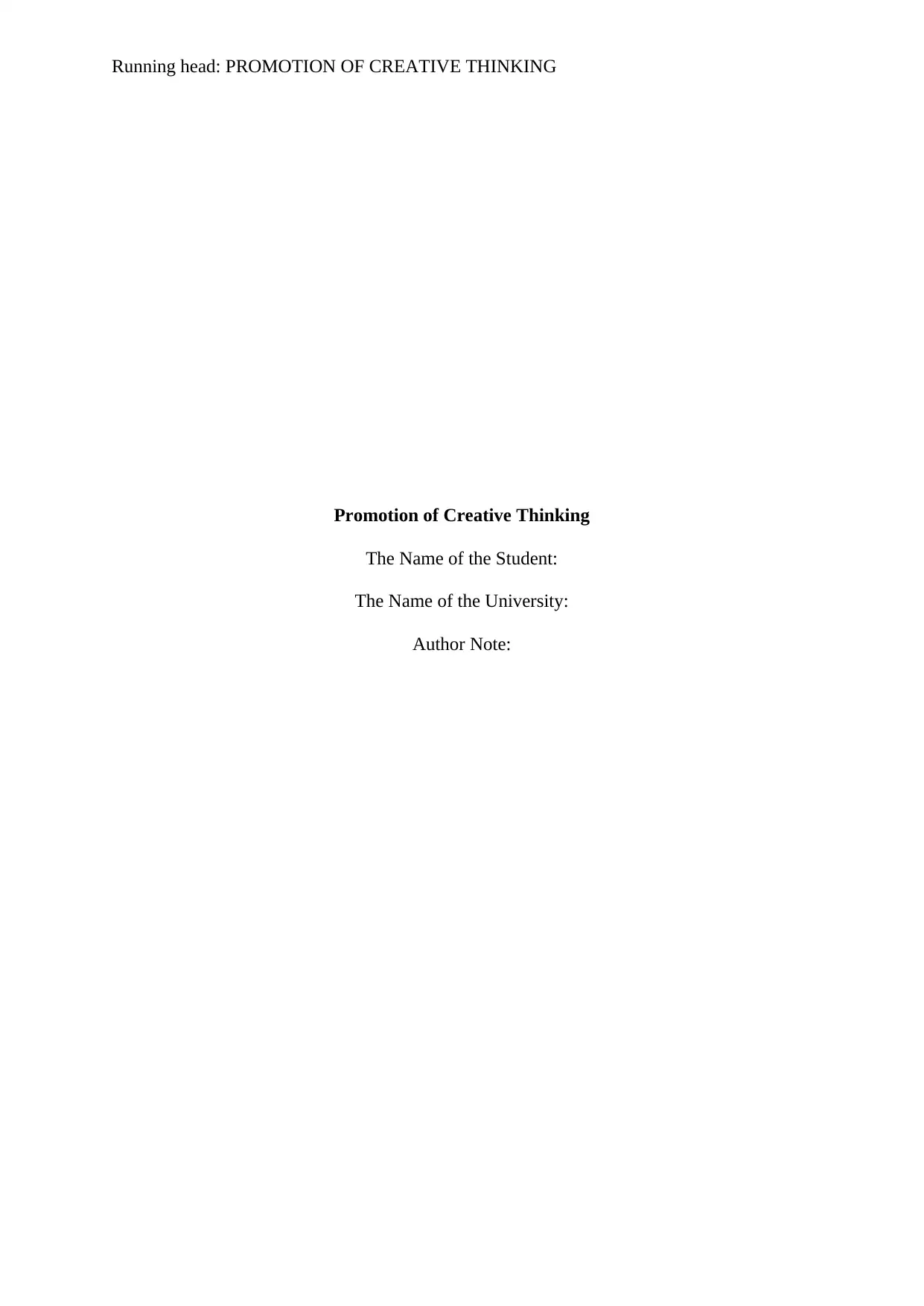
Running head: PROMOTION OF CREATIVE THINKING
Promotion of Creative Thinking
The Name of the Student:
The Name of the University:
Author Note:
Promotion of Creative Thinking
The Name of the Student:
The Name of the University:
Author Note:
Paraphrase This Document
Need a fresh take? Get an instant paraphrase of this document with our AI Paraphraser
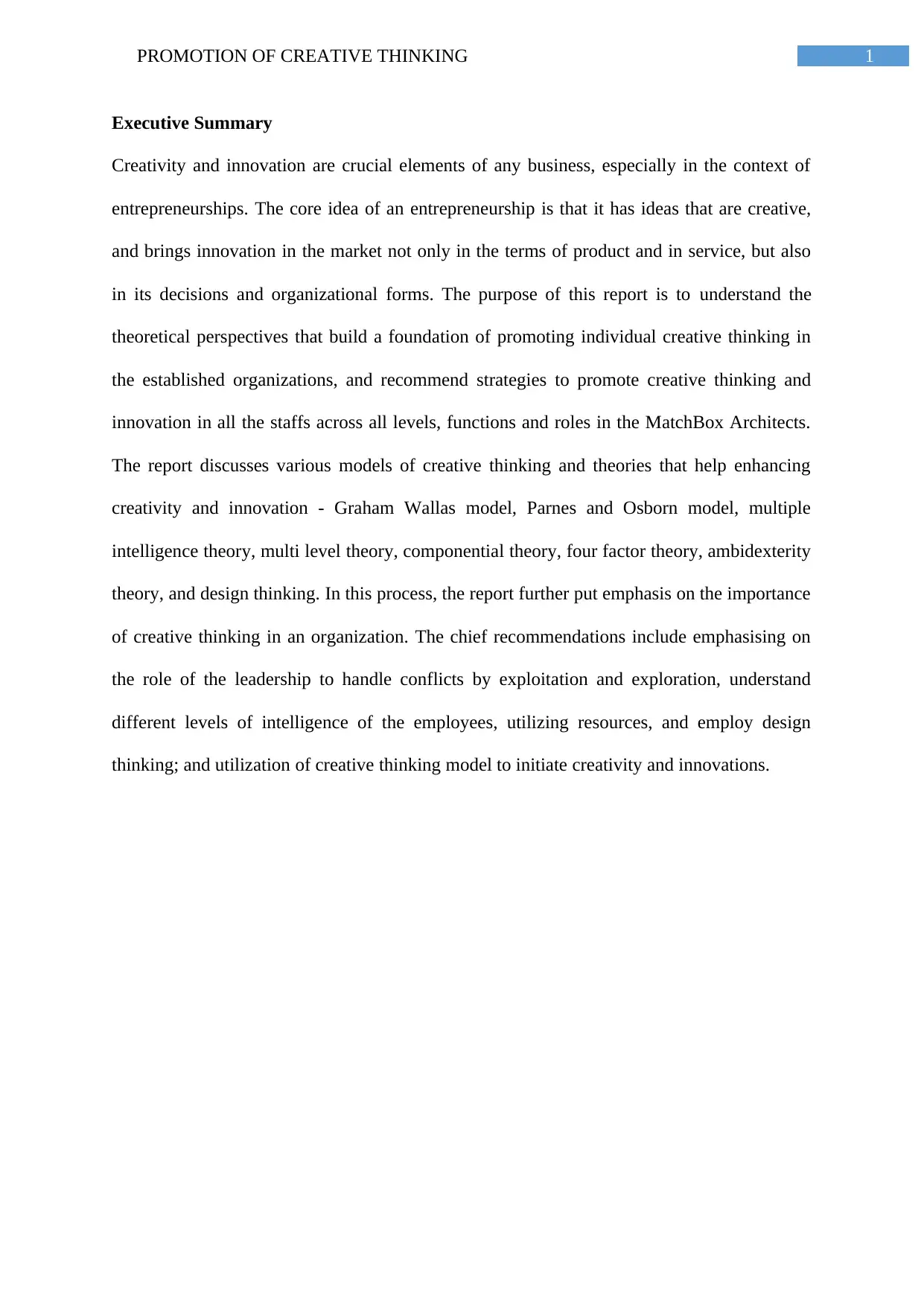
1PROMOTION OF CREATIVE THINKING
Executive Summary
Creativity and innovation are crucial elements of any business, especially in the context of
entrepreneurships. The core idea of an entrepreneurship is that it has ideas that are creative,
and brings innovation in the market not only in the terms of product and in service, but also
in its decisions and organizational forms. The purpose of this report is to understand the
theoretical perspectives that build a foundation of promoting individual creative thinking in
the established organizations, and recommend strategies to promote creative thinking and
innovation in all the staffs across all levels, functions and roles in the MatchBox Architects.
The report discusses various models of creative thinking and theories that help enhancing
creativity and innovation - Graham Wallas model, Parnes and Osborn model, multiple
intelligence theory, multi level theory, componential theory, four factor theory, ambidexterity
theory, and design thinking. In this process, the report further put emphasis on the importance
of creative thinking in an organization. The chief recommendations include emphasising on
the role of the leadership to handle conflicts by exploitation and exploration, understand
different levels of intelligence of the employees, utilizing resources, and employ design
thinking; and utilization of creative thinking model to initiate creativity and innovations.
Executive Summary
Creativity and innovation are crucial elements of any business, especially in the context of
entrepreneurships. The core idea of an entrepreneurship is that it has ideas that are creative,
and brings innovation in the market not only in the terms of product and in service, but also
in its decisions and organizational forms. The purpose of this report is to understand the
theoretical perspectives that build a foundation of promoting individual creative thinking in
the established organizations, and recommend strategies to promote creative thinking and
innovation in all the staffs across all levels, functions and roles in the MatchBox Architects.
The report discusses various models of creative thinking and theories that help enhancing
creativity and innovation - Graham Wallas model, Parnes and Osborn model, multiple
intelligence theory, multi level theory, componential theory, four factor theory, ambidexterity
theory, and design thinking. In this process, the report further put emphasis on the importance
of creative thinking in an organization. The chief recommendations include emphasising on
the role of the leadership to handle conflicts by exploitation and exploration, understand
different levels of intelligence of the employees, utilizing resources, and employ design
thinking; and utilization of creative thinking model to initiate creativity and innovations.
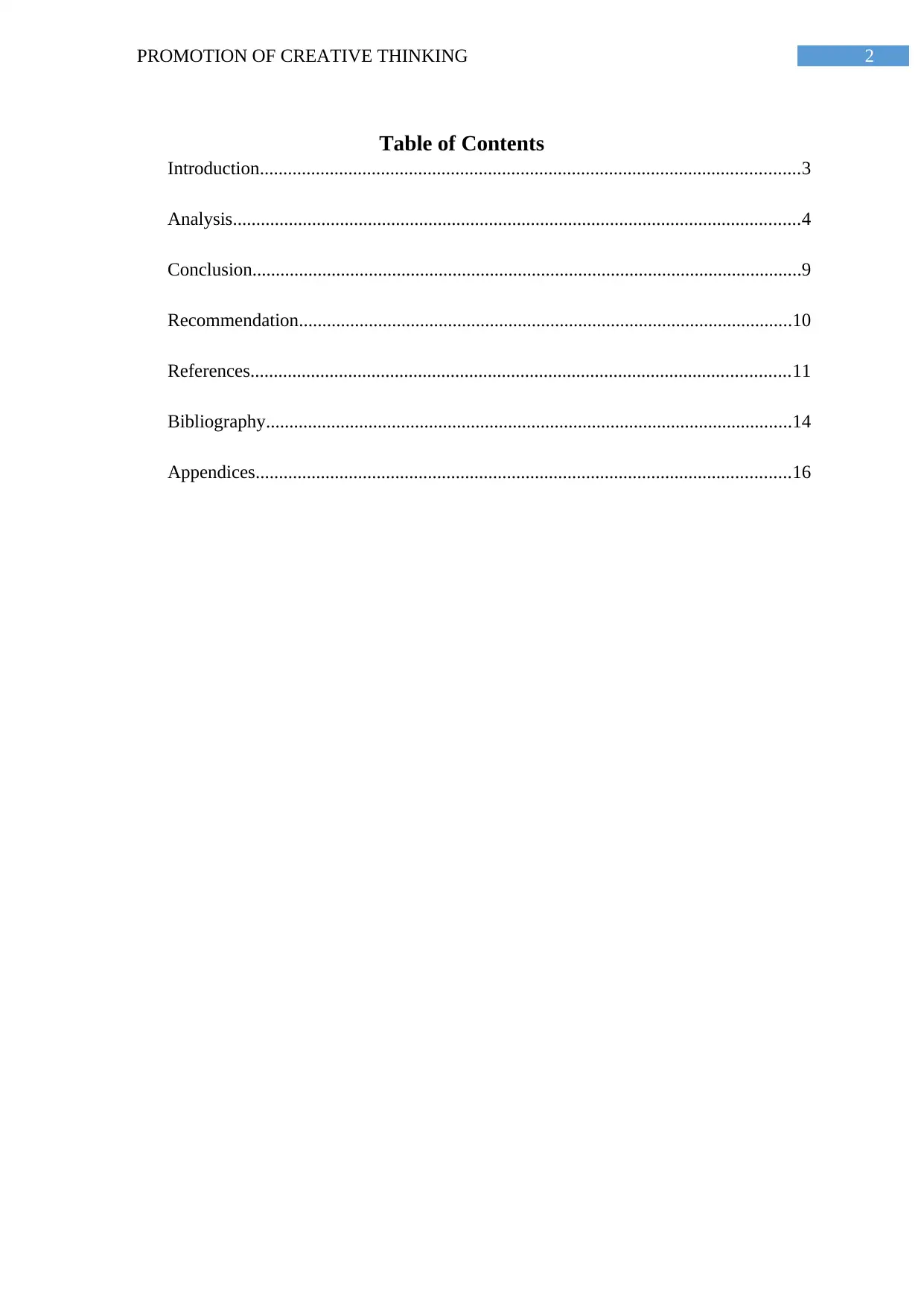
2PROMOTION OF CREATIVE THINKING
Table of Contents
Introduction....................................................................................................................3
Analysis..........................................................................................................................4
Conclusion......................................................................................................................9
Recommendation..........................................................................................................10
References....................................................................................................................11
Bibliography.................................................................................................................14
Appendices...................................................................................................................16
Table of Contents
Introduction....................................................................................................................3
Analysis..........................................................................................................................4
Conclusion......................................................................................................................9
Recommendation..........................................................................................................10
References....................................................................................................................11
Bibliography.................................................................................................................14
Appendices...................................................................................................................16
⊘ This is a preview!⊘
Do you want full access?
Subscribe today to unlock all pages.

Trusted by 1+ million students worldwide
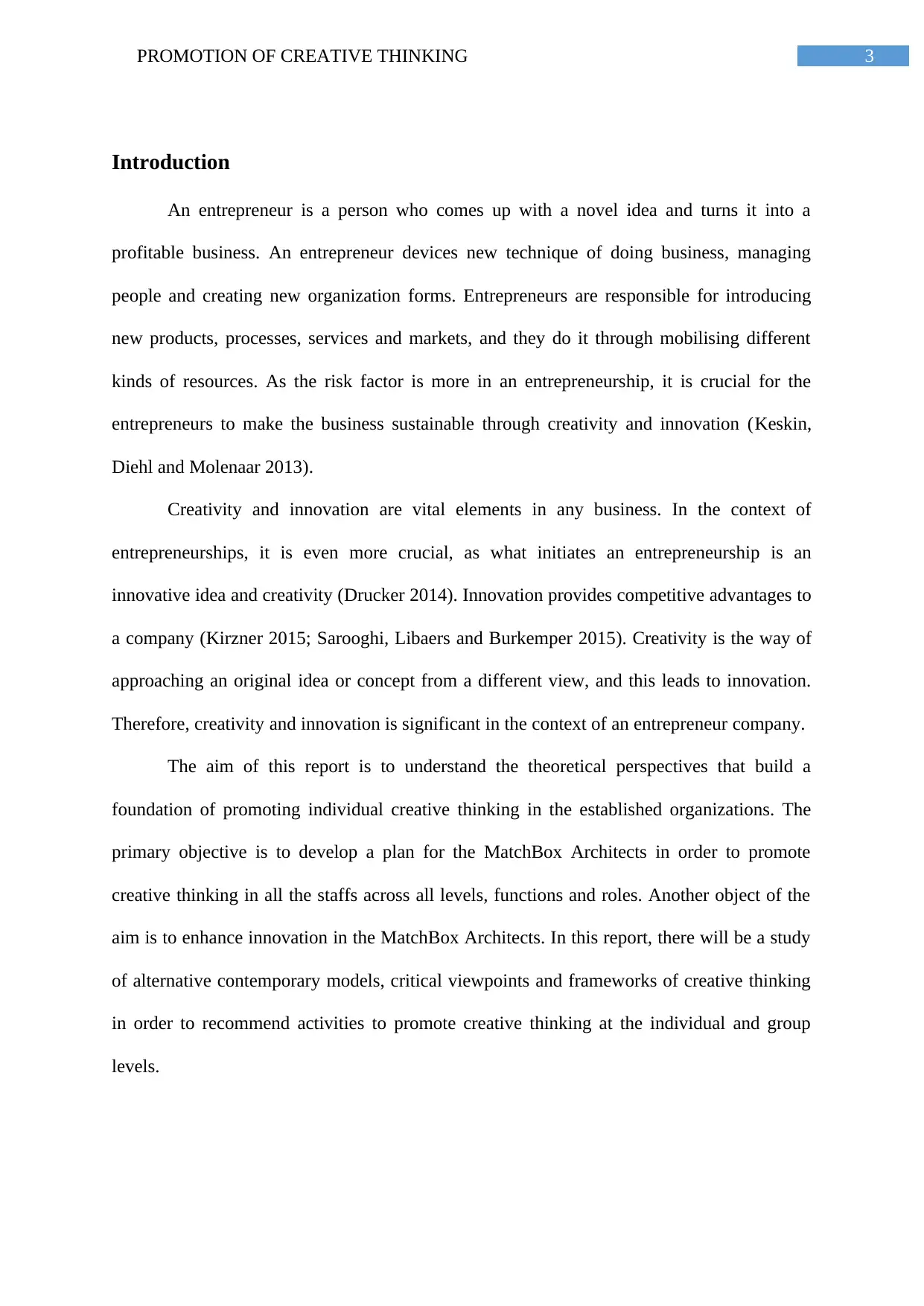
3PROMOTION OF CREATIVE THINKING
Introduction
An entrepreneur is a person who comes up with a novel idea and turns it into a
profitable business. An entrepreneur devices new technique of doing business, managing
people and creating new organization forms. Entrepreneurs are responsible for introducing
new products, processes, services and markets, and they do it through mobilising different
kinds of resources. As the risk factor is more in an entrepreneurship, it is crucial for the
entrepreneurs to make the business sustainable through creativity and innovation (Keskin,
Diehl and Molenaar 2013).
Creativity and innovation are vital elements in any business. In the context of
entrepreneurships, it is even more crucial, as what initiates an entrepreneurship is an
innovative idea and creativity (Drucker 2014). Innovation provides competitive advantages to
a company (Kirzner 2015; Sarooghi, Libaers and Burkemper 2015). Creativity is the way of
approaching an original idea or concept from a different view, and this leads to innovation.
Therefore, creativity and innovation is significant in the context of an entrepreneur company.
The aim of this report is to understand the theoretical perspectives that build a
foundation of promoting individual creative thinking in the established organizations. The
primary objective is to develop a plan for the MatchBox Architects in order to promote
creative thinking in all the staffs across all levels, functions and roles. Another object of the
aim is to enhance innovation in the MatchBox Architects. In this report, there will be a study
of alternative contemporary models, critical viewpoints and frameworks of creative thinking
in order to recommend activities to promote creative thinking at the individual and group
levels.
Introduction
An entrepreneur is a person who comes up with a novel idea and turns it into a
profitable business. An entrepreneur devices new technique of doing business, managing
people and creating new organization forms. Entrepreneurs are responsible for introducing
new products, processes, services and markets, and they do it through mobilising different
kinds of resources. As the risk factor is more in an entrepreneurship, it is crucial for the
entrepreneurs to make the business sustainable through creativity and innovation (Keskin,
Diehl and Molenaar 2013).
Creativity and innovation are vital elements in any business. In the context of
entrepreneurships, it is even more crucial, as what initiates an entrepreneurship is an
innovative idea and creativity (Drucker 2014). Innovation provides competitive advantages to
a company (Kirzner 2015; Sarooghi, Libaers and Burkemper 2015). Creativity is the way of
approaching an original idea or concept from a different view, and this leads to innovation.
Therefore, creativity and innovation is significant in the context of an entrepreneur company.
The aim of this report is to understand the theoretical perspectives that build a
foundation of promoting individual creative thinking in the established organizations. The
primary objective is to develop a plan for the MatchBox Architects in order to promote
creative thinking in all the staffs across all levels, functions and roles. Another object of the
aim is to enhance innovation in the MatchBox Architects. In this report, there will be a study
of alternative contemporary models, critical viewpoints and frameworks of creative thinking
in order to recommend activities to promote creative thinking at the individual and group
levels.
Paraphrase This Document
Need a fresh take? Get an instant paraphrase of this document with our AI Paraphraser
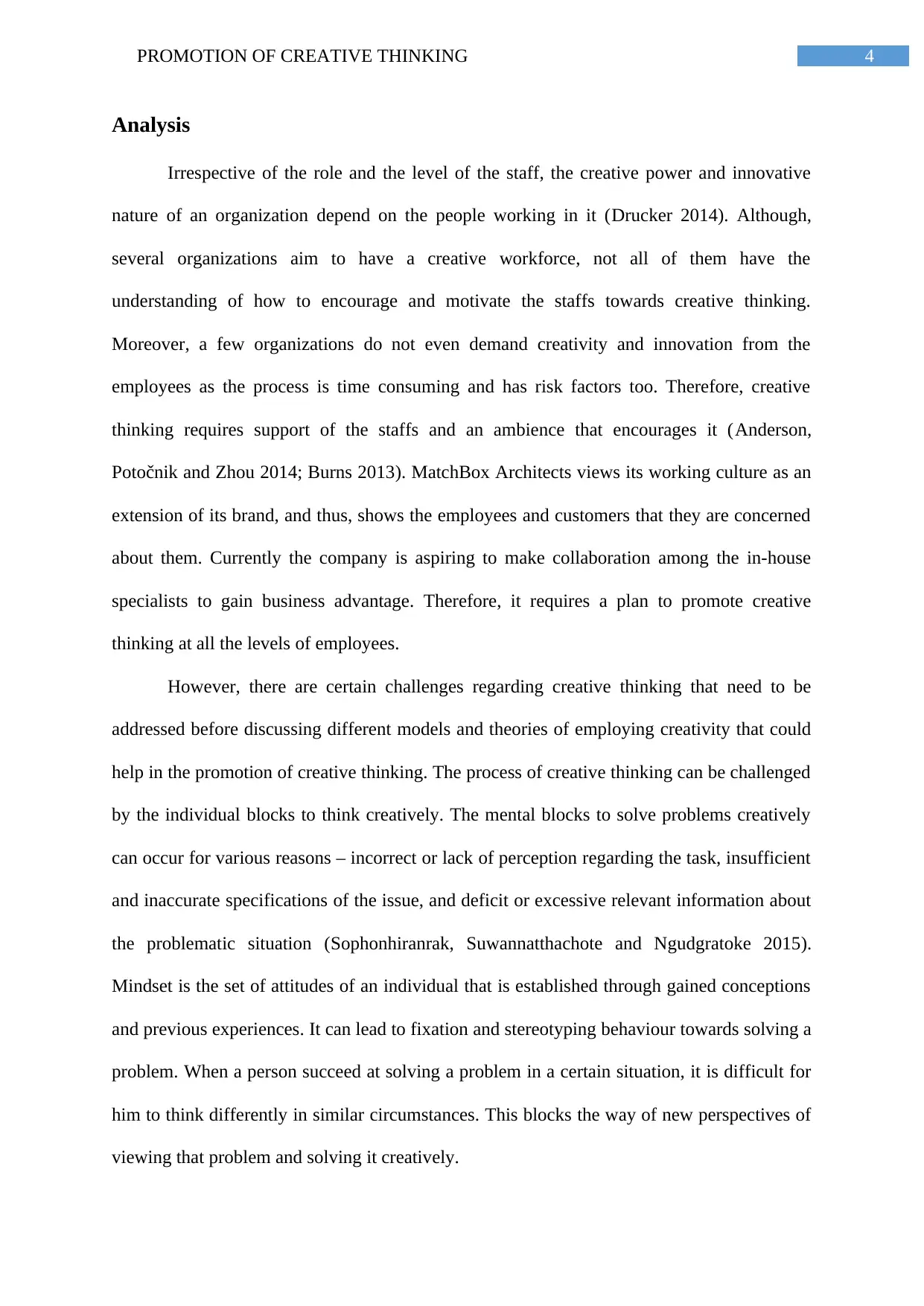
4PROMOTION OF CREATIVE THINKING
Analysis
Irrespective of the role and the level of the staff, the creative power and innovative
nature of an organization depend on the people working in it (Drucker 2014). Although,
several organizations aim to have a creative workforce, not all of them have the
understanding of how to encourage and motivate the staffs towards creative thinking.
Moreover, a few organizations do not even demand creativity and innovation from the
employees as the process is time consuming and has risk factors too. Therefore, creative
thinking requires support of the staffs and an ambience that encourages it (Anderson,
Potočnik and Zhou 2014; Burns 2013). MatchBox Architects views its working culture as an
extension of its brand, and thus, shows the employees and customers that they are concerned
about them. Currently the company is aspiring to make collaboration among the in-house
specialists to gain business advantage. Therefore, it requires a plan to promote creative
thinking at all the levels of employees.
However, there are certain challenges regarding creative thinking that need to be
addressed before discussing different models and theories of employing creativity that could
help in the promotion of creative thinking. The process of creative thinking can be challenged
by the individual blocks to think creatively. The mental blocks to solve problems creatively
can occur for various reasons – incorrect or lack of perception regarding the task, insufficient
and inaccurate specifications of the issue, and deficit or excessive relevant information about
the problematic situation (Sophonhiranrak, Suwannatthachote and Ngudgratoke 2015).
Mindset is the set of attitudes of an individual that is established through gained conceptions
and previous experiences. It can lead to fixation and stereotyping behaviour towards solving a
problem. When a person succeed at solving a problem in a certain situation, it is difficult for
him to think differently in similar circumstances. This blocks the way of new perspectives of
viewing that problem and solving it creatively.
Analysis
Irrespective of the role and the level of the staff, the creative power and innovative
nature of an organization depend on the people working in it (Drucker 2014). Although,
several organizations aim to have a creative workforce, not all of them have the
understanding of how to encourage and motivate the staffs towards creative thinking.
Moreover, a few organizations do not even demand creativity and innovation from the
employees as the process is time consuming and has risk factors too. Therefore, creative
thinking requires support of the staffs and an ambience that encourages it (Anderson,
Potočnik and Zhou 2014; Burns 2013). MatchBox Architects views its working culture as an
extension of its brand, and thus, shows the employees and customers that they are concerned
about them. Currently the company is aspiring to make collaboration among the in-house
specialists to gain business advantage. Therefore, it requires a plan to promote creative
thinking at all the levels of employees.
However, there are certain challenges regarding creative thinking that need to be
addressed before discussing different models and theories of employing creativity that could
help in the promotion of creative thinking. The process of creative thinking can be challenged
by the individual blocks to think creatively. The mental blocks to solve problems creatively
can occur for various reasons – incorrect or lack of perception regarding the task, insufficient
and inaccurate specifications of the issue, and deficit or excessive relevant information about
the problematic situation (Sophonhiranrak, Suwannatthachote and Ngudgratoke 2015).
Mindset is the set of attitudes of an individual that is established through gained conceptions
and previous experiences. It can lead to fixation and stereotyping behaviour towards solving a
problem. When a person succeed at solving a problem in a certain situation, it is difficult for
him to think differently in similar circumstances. This blocks the way of new perspectives of
viewing that problem and solving it creatively.
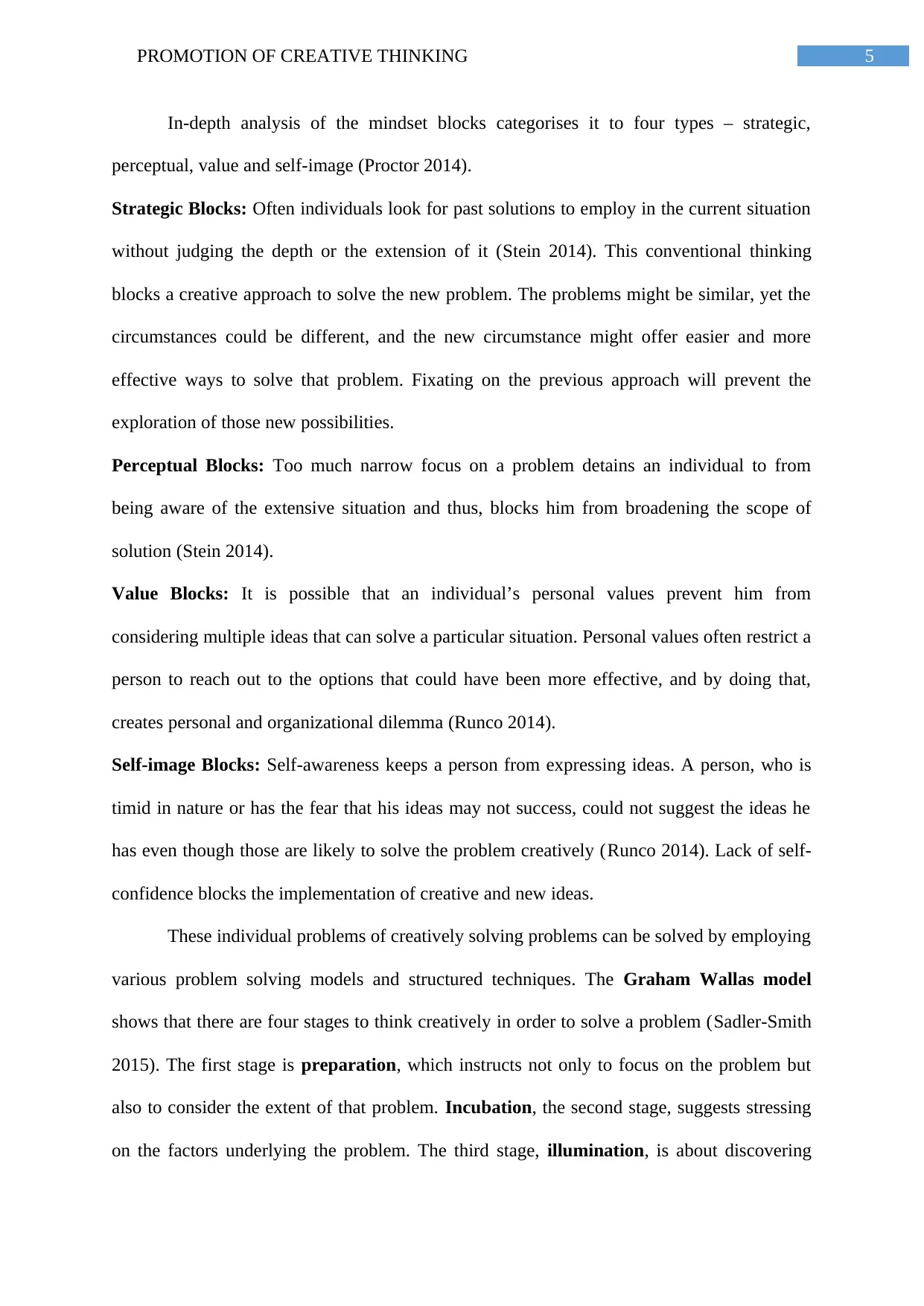
5PROMOTION OF CREATIVE THINKING
In-depth analysis of the mindset blocks categorises it to four types – strategic,
perceptual, value and self-image (Proctor 2014).
Strategic Blocks: Often individuals look for past solutions to employ in the current situation
without judging the depth or the extension of it (Stein 2014). This conventional thinking
blocks a creative approach to solve the new problem. The problems might be similar, yet the
circumstances could be different, and the new circumstance might offer easier and more
effective ways to solve that problem. Fixating on the previous approach will prevent the
exploration of those new possibilities.
Perceptual Blocks: Too much narrow focus on a problem detains an individual to from
being aware of the extensive situation and thus, blocks him from broadening the scope of
solution (Stein 2014).
Value Blocks: It is possible that an individual’s personal values prevent him from
considering multiple ideas that can solve a particular situation. Personal values often restrict a
person to reach out to the options that could have been more effective, and by doing that,
creates personal and organizational dilemma (Runco 2014).
Self-image Blocks: Self-awareness keeps a person from expressing ideas. A person, who is
timid in nature or has the fear that his ideas may not success, could not suggest the ideas he
has even though those are likely to solve the problem creatively (Runco 2014). Lack of self-
confidence blocks the implementation of creative and new ideas.
These individual problems of creatively solving problems can be solved by employing
various problem solving models and structured techniques. The Graham Wallas model
shows that there are four stages to think creatively in order to solve a problem (Sadler-Smith
2015). The first stage is preparation, which instructs not only to focus on the problem but
also to consider the extent of that problem. Incubation, the second stage, suggests stressing
on the factors underlying the problem. The third stage, illumination, is about discovering
In-depth analysis of the mindset blocks categorises it to four types – strategic,
perceptual, value and self-image (Proctor 2014).
Strategic Blocks: Often individuals look for past solutions to employ in the current situation
without judging the depth or the extension of it (Stein 2014). This conventional thinking
blocks a creative approach to solve the new problem. The problems might be similar, yet the
circumstances could be different, and the new circumstance might offer easier and more
effective ways to solve that problem. Fixating on the previous approach will prevent the
exploration of those new possibilities.
Perceptual Blocks: Too much narrow focus on a problem detains an individual to from
being aware of the extensive situation and thus, blocks him from broadening the scope of
solution (Stein 2014).
Value Blocks: It is possible that an individual’s personal values prevent him from
considering multiple ideas that can solve a particular situation. Personal values often restrict a
person to reach out to the options that could have been more effective, and by doing that,
creates personal and organizational dilemma (Runco 2014).
Self-image Blocks: Self-awareness keeps a person from expressing ideas. A person, who is
timid in nature or has the fear that his ideas may not success, could not suggest the ideas he
has even though those are likely to solve the problem creatively (Runco 2014). Lack of self-
confidence blocks the implementation of creative and new ideas.
These individual problems of creatively solving problems can be solved by employing
various problem solving models and structured techniques. The Graham Wallas model
shows that there are four stages to think creatively in order to solve a problem (Sadler-Smith
2015). The first stage is preparation, which instructs not only to focus on the problem but
also to consider the extent of that problem. Incubation, the second stage, suggests stressing
on the factors underlying the problem. The third stage, illumination, is about discovering
⊘ This is a preview!⊘
Do you want full access?
Subscribe today to unlock all pages.

Trusted by 1+ million students worldwide

6PROMOTION OF CREATIVE THINKING
plausible ways of solving the problem. The fourth stage is verification and it focuses on the
solution that is effective, innovative, practical and appropriate for solving the problem.
The Parnes and Osborn model suggests that six steps – mess-finding, fact-finding,
problem-finding, idea-finding, solution-finding, and acceptance-finding - can solve a
problem creatively (Sousa et al. 2014). This model believes that problems occur in clusters as
the effect of one another (Ravenell 2018). Mess-finding is the step to identify the measures of
effectiveness to understand the competency and effectiveness of the existing system. Fact-
finding is the step, where the focus is on gathering information on the problem to
comprehend it. This step helps in avoiding premature evaluation of the problems. Problem-
finding is the step that identifies the root of the mess that is the real problem. The purpose of
the idea-finding step is to brainstorm several creative alternative solutions for the problems.
Solution-finding means to select the best possible solution from the alternatives. The final
step, acceptance-finding, is about planning the implementation of the selected solution. This
model helps in balancing the convergent and divergent thinking process.
The multiple intelligence theory by Howard Gardner is developed on the belief
that everyone has creativity in specific fields (Strauss 2013). At first, the theory included
eight specific intelligences that help a person to solve various problems. These intelligences
are musical, kinesthetic, visual-spatial, naturalistic, linguistic, logical, interpersonal and
intrapersonal. Later, he mentioned that existential and moral intelligences could also be
included in the list (Strauss 2013). According to Gardner, everyone has different capabilities
and therefore, learns differently (Gardner 2018). His theory implies the fact that a single
approach cannot bring out the creativeness from everyone, as each people responds
differently. It further indicates that employees in an organization should be utilized according
to their specific strengths to get the best result from them.
plausible ways of solving the problem. The fourth stage is verification and it focuses on the
solution that is effective, innovative, practical and appropriate for solving the problem.
The Parnes and Osborn model suggests that six steps – mess-finding, fact-finding,
problem-finding, idea-finding, solution-finding, and acceptance-finding - can solve a
problem creatively (Sousa et al. 2014). This model believes that problems occur in clusters as
the effect of one another (Ravenell 2018). Mess-finding is the step to identify the measures of
effectiveness to understand the competency and effectiveness of the existing system. Fact-
finding is the step, where the focus is on gathering information on the problem to
comprehend it. This step helps in avoiding premature evaluation of the problems. Problem-
finding is the step that identifies the root of the mess that is the real problem. The purpose of
the idea-finding step is to brainstorm several creative alternative solutions for the problems.
Solution-finding means to select the best possible solution from the alternatives. The final
step, acceptance-finding, is about planning the implementation of the selected solution. This
model helps in balancing the convergent and divergent thinking process.
The multiple intelligence theory by Howard Gardner is developed on the belief
that everyone has creativity in specific fields (Strauss 2013). At first, the theory included
eight specific intelligences that help a person to solve various problems. These intelligences
are musical, kinesthetic, visual-spatial, naturalistic, linguistic, logical, interpersonal and
intrapersonal. Later, he mentioned that existential and moral intelligences could also be
included in the list (Strauss 2013). According to Gardner, everyone has different capabilities
and therefore, learns differently (Gardner 2018). His theory implies the fact that a single
approach cannot bring out the creativeness from everyone, as each people responds
differently. It further indicates that employees in an organization should be utilized according
to their specific strengths to get the best result from them.
Paraphrase This Document
Need a fresh take? Get an instant paraphrase of this document with our AI Paraphraser
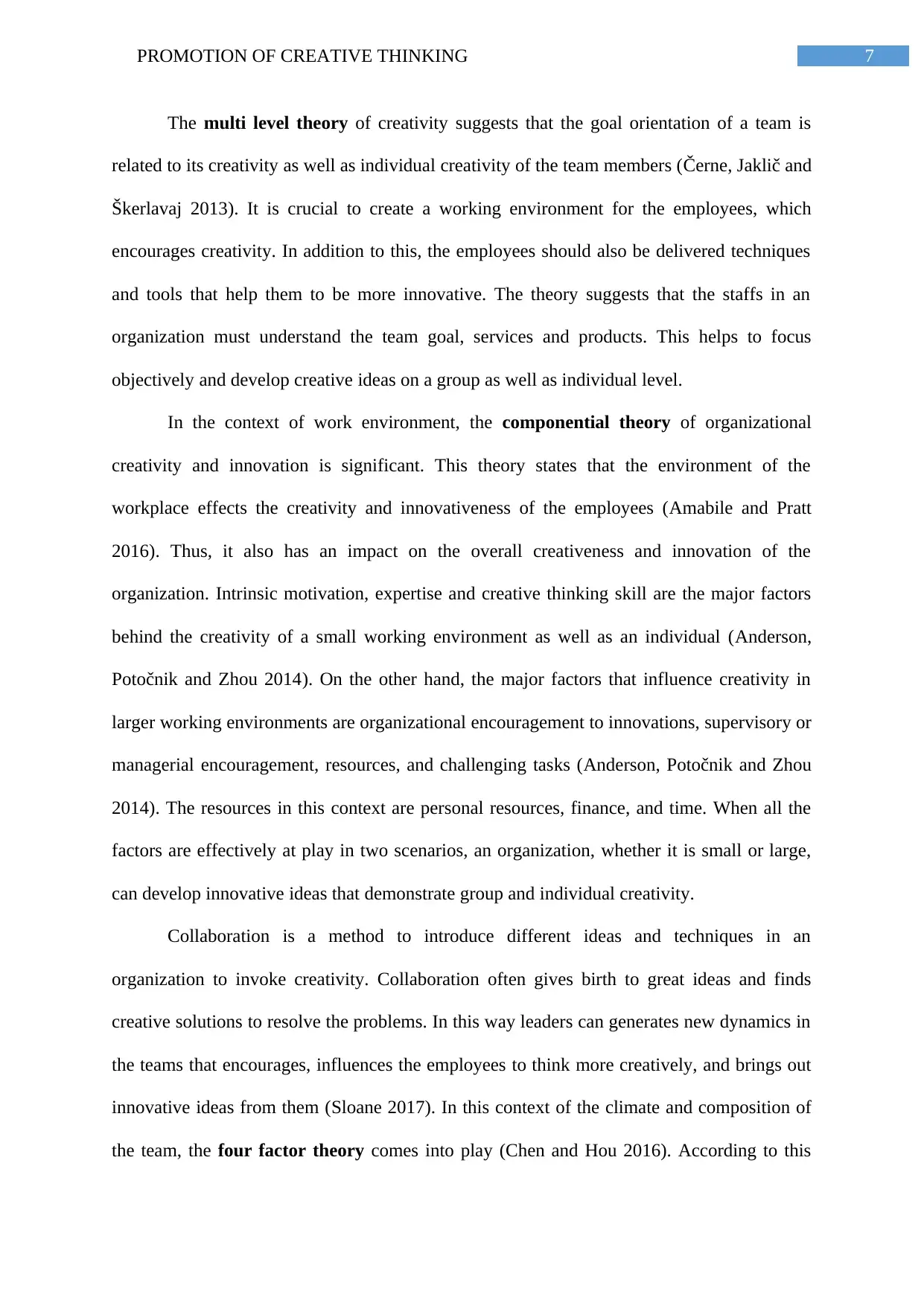
7PROMOTION OF CREATIVE THINKING
The multi level theory of creativity suggests that the goal orientation of a team is
related to its creativity as well as individual creativity of the team members (Černe, Jaklič and
Škerlavaj 2013). It is crucial to create a working environment for the employees, which
encourages creativity. In addition to this, the employees should also be delivered techniques
and tools that help them to be more innovative. The theory suggests that the staffs in an
organization must understand the team goal, services and products. This helps to focus
objectively and develop creative ideas on a group as well as individual level.
In the context of work environment, the componential theory of organizational
creativity and innovation is significant. This theory states that the environment of the
workplace effects the creativity and innovativeness of the employees (Amabile and Pratt
2016). Thus, it also has an impact on the overall creativeness and innovation of the
organization. Intrinsic motivation, expertise and creative thinking skill are the major factors
behind the creativity of a small working environment as well as an individual (Anderson,
Potočnik and Zhou 2014). On the other hand, the major factors that influence creativity in
larger working environments are organizational encouragement to innovations, supervisory or
managerial encouragement, resources, and challenging tasks (Anderson, Potočnik and Zhou
2014). The resources in this context are personal resources, finance, and time. When all the
factors are effectively at play in two scenarios, an organization, whether it is small or large,
can develop innovative ideas that demonstrate group and individual creativity.
Collaboration is a method to introduce different ideas and techniques in an
organization to invoke creativity. Collaboration often gives birth to great ideas and finds
creative solutions to resolve the problems. In this way leaders can generates new dynamics in
the teams that encourages, influences the employees to think more creatively, and brings out
innovative ideas from them (Sloane 2017). In this context of the climate and composition of
the team, the four factor theory comes into play (Chen and Hou 2016). According to this
The multi level theory of creativity suggests that the goal orientation of a team is
related to its creativity as well as individual creativity of the team members (Černe, Jaklič and
Škerlavaj 2013). It is crucial to create a working environment for the employees, which
encourages creativity. In addition to this, the employees should also be delivered techniques
and tools that help them to be more innovative. The theory suggests that the staffs in an
organization must understand the team goal, services and products. This helps to focus
objectively and develop creative ideas on a group as well as individual level.
In the context of work environment, the componential theory of organizational
creativity and innovation is significant. This theory states that the environment of the
workplace effects the creativity and innovativeness of the employees (Amabile and Pratt
2016). Thus, it also has an impact on the overall creativeness and innovation of the
organization. Intrinsic motivation, expertise and creative thinking skill are the major factors
behind the creativity of a small working environment as well as an individual (Anderson,
Potočnik and Zhou 2014). On the other hand, the major factors that influence creativity in
larger working environments are organizational encouragement to innovations, supervisory or
managerial encouragement, resources, and challenging tasks (Anderson, Potočnik and Zhou
2014). The resources in this context are personal resources, finance, and time. When all the
factors are effectively at play in two scenarios, an organization, whether it is small or large,
can develop innovative ideas that demonstrate group and individual creativity.
Collaboration is a method to introduce different ideas and techniques in an
organization to invoke creativity. Collaboration often gives birth to great ideas and finds
creative solutions to resolve the problems. In this way leaders can generates new dynamics in
the teams that encourages, influences the employees to think more creatively, and brings out
innovative ideas from them (Sloane 2017). In this context of the climate and composition of
the team, the four factor theory comes into play (Chen and Hou 2016). According to this
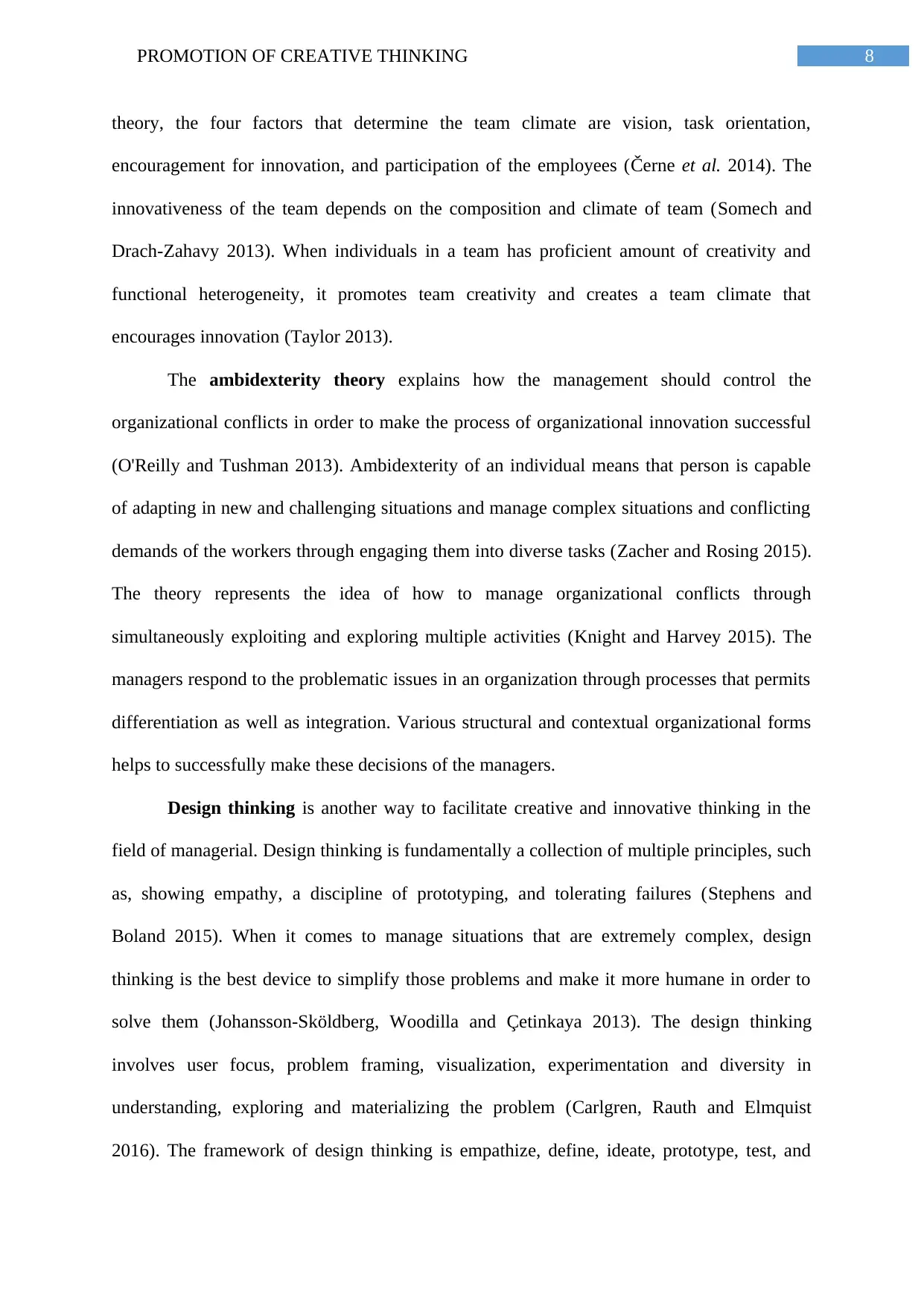
8PROMOTION OF CREATIVE THINKING
theory, the four factors that determine the team climate are vision, task orientation,
encouragement for innovation, and participation of the employees (Černe et al. 2014). The
innovativeness of the team depends on the composition and climate of team (Somech and
Drach-Zahavy 2013). When individuals in a team has proficient amount of creativity and
functional heterogeneity, it promotes team creativity and creates a team climate that
encourages innovation (Taylor 2013).
The ambidexterity theory explains how the management should control the
organizational conflicts in order to make the process of organizational innovation successful
(O'Reilly and Tushman 2013). Ambidexterity of an individual means that person is capable
of adapting in new and challenging situations and manage complex situations and conflicting
demands of the workers through engaging them into diverse tasks (Zacher and Rosing 2015).
The theory represents the idea of how to manage organizational conflicts through
simultaneously exploiting and exploring multiple activities (Knight and Harvey 2015). The
managers respond to the problematic issues in an organization through processes that permits
differentiation as well as integration. Various structural and contextual organizational forms
helps to successfully make these decisions of the managers.
Design thinking is another way to facilitate creative and innovative thinking in the
field of managerial. Design thinking is fundamentally a collection of multiple principles, such
as, showing empathy, a discipline of prototyping, and tolerating failures (Stephens and
Boland 2015). When it comes to manage situations that are extremely complex, design
thinking is the best device to simplify those problems and make it more humane in order to
solve them (Johansson-Sköldberg, Woodilla and Çetinkaya 2013). The design thinking
involves user focus, problem framing, visualization, experimentation and diversity in
understanding, exploring and materializing the problem (Carlgren, Rauth and Elmquist
2016). The framework of design thinking is empathize, define, ideate, prototype, test, and
theory, the four factors that determine the team climate are vision, task orientation,
encouragement for innovation, and participation of the employees (Černe et al. 2014). The
innovativeness of the team depends on the composition and climate of team (Somech and
Drach-Zahavy 2013). When individuals in a team has proficient amount of creativity and
functional heterogeneity, it promotes team creativity and creates a team climate that
encourages innovation (Taylor 2013).
The ambidexterity theory explains how the management should control the
organizational conflicts in order to make the process of organizational innovation successful
(O'Reilly and Tushman 2013). Ambidexterity of an individual means that person is capable
of adapting in new and challenging situations and manage complex situations and conflicting
demands of the workers through engaging them into diverse tasks (Zacher and Rosing 2015).
The theory represents the idea of how to manage organizational conflicts through
simultaneously exploiting and exploring multiple activities (Knight and Harvey 2015). The
managers respond to the problematic issues in an organization through processes that permits
differentiation as well as integration. Various structural and contextual organizational forms
helps to successfully make these decisions of the managers.
Design thinking is another way to facilitate creative and innovative thinking in the
field of managerial. Design thinking is fundamentally a collection of multiple principles, such
as, showing empathy, a discipline of prototyping, and tolerating failures (Stephens and
Boland 2015). When it comes to manage situations that are extremely complex, design
thinking is the best device to simplify those problems and make it more humane in order to
solve them (Johansson-Sköldberg, Woodilla and Çetinkaya 2013). The design thinking
involves user focus, problem framing, visualization, experimentation and diversity in
understanding, exploring and materializing the problem (Carlgren, Rauth and Elmquist
2016). The framework of design thinking is empathize, define, ideate, prototype, test, and
⊘ This is a preview!⊘
Do you want full access?
Subscribe today to unlock all pages.

Trusted by 1+ million students worldwide

9PROMOTION OF CREATIVE THINKING
implement. In the context of invoking creativity, it is an essential tool as it approaches the
problem in a different way. Therefore, it should be utilized as a core device to initiate
creativity.
Conclusion
This review of the literatures fulfils the aim of the report, which is to understand the
theoretical perspectives that build a foundation of promoting individual creative thinking in
the established organizations. This evaluation establishes the key concepts of the process of
developing creativity and innovation in a working environment, which will help the objective
of this report to plan and recommend strategies to promote creative thinking in the MatchBox
Architects and enhance the innovativeness of its employees. At first, the report discusses the
reasons that can result into blocks to think and solve problems creatively in an individual.
Then, the report discusses models such as Graham Wallas model and Parnes and Osborn
model of creative thinking, and multiple intelligence theory, multi level theory, componential
theory, four factor theory, ambidexterity theory, and design thinking to emphasis on different
factors that affect the creative thinking and innovativeness of an individual as well as a group.
The models of creative thinking mainly focus on deep understanding of the problems
and think of diverse ways of solving those problems in order to bring out the most creative
one. The theories provide the idea that different personal skills have vital role in the process
of creative thinking. Therefore, it is justified to say that the evaluative discussion of the
contemporary theories, frameworks, models, and critical view points are the primary ways of
promoting creativity and innovation in an established organization. In addition to this, this
review of the literature enhances the importance of creativity and innovation in the field of
business.
implement. In the context of invoking creativity, it is an essential tool as it approaches the
problem in a different way. Therefore, it should be utilized as a core device to initiate
creativity.
Conclusion
This review of the literatures fulfils the aim of the report, which is to understand the
theoretical perspectives that build a foundation of promoting individual creative thinking in
the established organizations. This evaluation establishes the key concepts of the process of
developing creativity and innovation in a working environment, which will help the objective
of this report to plan and recommend strategies to promote creative thinking in the MatchBox
Architects and enhance the innovativeness of its employees. At first, the report discusses the
reasons that can result into blocks to think and solve problems creatively in an individual.
Then, the report discusses models such as Graham Wallas model and Parnes and Osborn
model of creative thinking, and multiple intelligence theory, multi level theory, componential
theory, four factor theory, ambidexterity theory, and design thinking to emphasis on different
factors that affect the creative thinking and innovativeness of an individual as well as a group.
The models of creative thinking mainly focus on deep understanding of the problems
and think of diverse ways of solving those problems in order to bring out the most creative
one. The theories provide the idea that different personal skills have vital role in the process
of creative thinking. Therefore, it is justified to say that the evaluative discussion of the
contemporary theories, frameworks, models, and critical view points are the primary ways of
promoting creativity and innovation in an established organization. In addition to this, this
review of the literature enhances the importance of creativity and innovation in the field of
business.
Paraphrase This Document
Need a fresh take? Get an instant paraphrase of this document with our AI Paraphraser
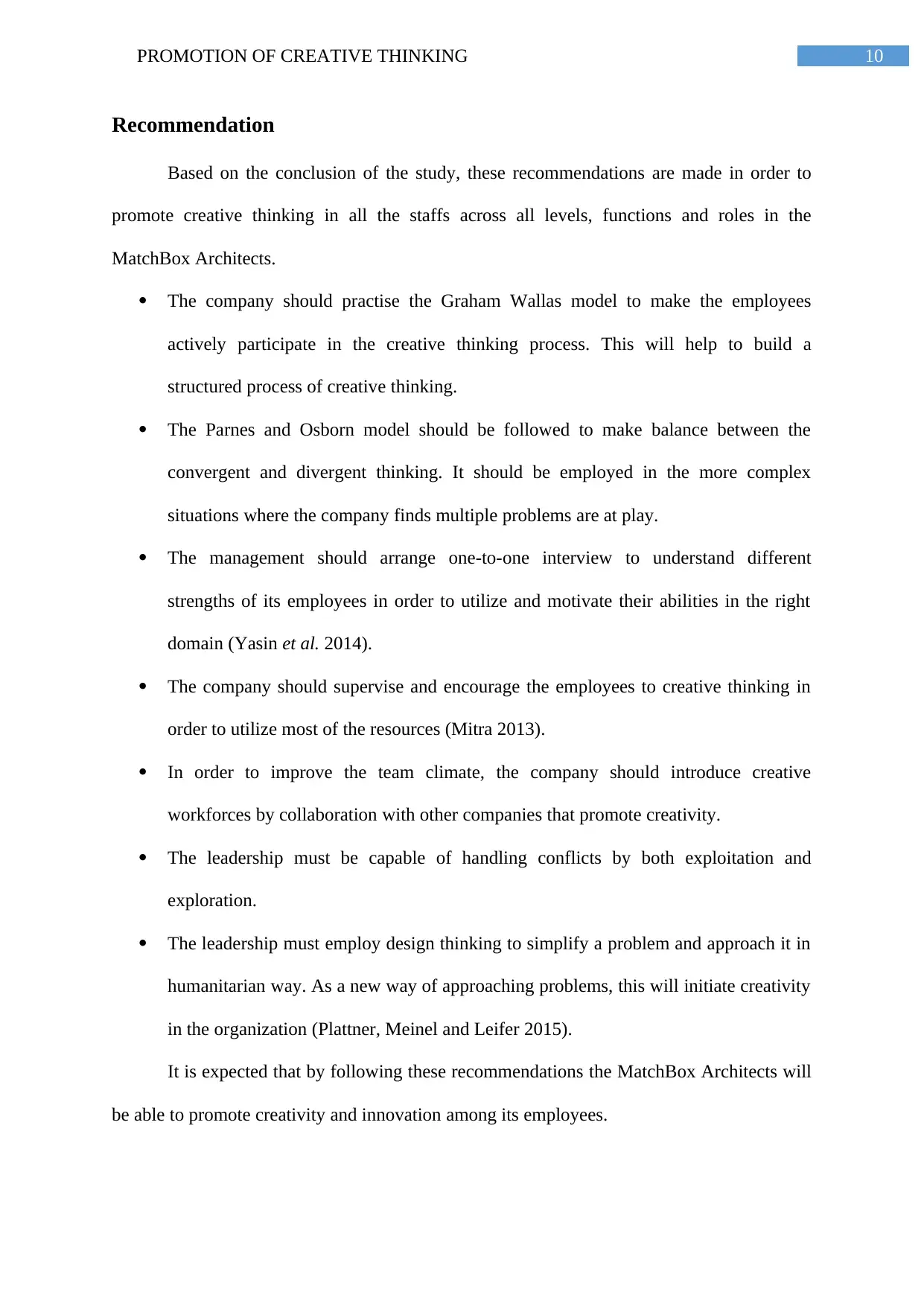
10PROMOTION OF CREATIVE THINKING
Recommendation
Based on the conclusion of the study, these recommendations are made in order to
promote creative thinking in all the staffs across all levels, functions and roles in the
MatchBox Architects.
The company should practise the Graham Wallas model to make the employees
actively participate in the creative thinking process. This will help to build a
structured process of creative thinking.
The Parnes and Osborn model should be followed to make balance between the
convergent and divergent thinking. It should be employed in the more complex
situations where the company finds multiple problems are at play.
The management should arrange one-to-one interview to understand different
strengths of its employees in order to utilize and motivate their abilities in the right
domain (Yasin et al. 2014).
The company should supervise and encourage the employees to creative thinking in
order to utilize most of the resources (Mitra 2013).
In order to improve the team climate, the company should introduce creative
workforces by collaboration with other companies that promote creativity.
The leadership must be capable of handling conflicts by both exploitation and
exploration.
The leadership must employ design thinking to simplify a problem and approach it in
humanitarian way. As a new way of approaching problems, this will initiate creativity
in the organization (Plattner, Meinel and Leifer 2015).
It is expected that by following these recommendations the MatchBox Architects will
be able to promote creativity and innovation among its employees.
Recommendation
Based on the conclusion of the study, these recommendations are made in order to
promote creative thinking in all the staffs across all levels, functions and roles in the
MatchBox Architects.
The company should practise the Graham Wallas model to make the employees
actively participate in the creative thinking process. This will help to build a
structured process of creative thinking.
The Parnes and Osborn model should be followed to make balance between the
convergent and divergent thinking. It should be employed in the more complex
situations where the company finds multiple problems are at play.
The management should arrange one-to-one interview to understand different
strengths of its employees in order to utilize and motivate their abilities in the right
domain (Yasin et al. 2014).
The company should supervise and encourage the employees to creative thinking in
order to utilize most of the resources (Mitra 2013).
In order to improve the team climate, the company should introduce creative
workforces by collaboration with other companies that promote creativity.
The leadership must be capable of handling conflicts by both exploitation and
exploration.
The leadership must employ design thinking to simplify a problem and approach it in
humanitarian way. As a new way of approaching problems, this will initiate creativity
in the organization (Plattner, Meinel and Leifer 2015).
It is expected that by following these recommendations the MatchBox Architects will
be able to promote creativity and innovation among its employees.

11PROMOTION OF CREATIVE THINKING
References
Amabile, T.M. and Pratt, M.G., 2016. The dynamic componential model of creativity and
innovation in organizations: Making progress, making meaning. Research in Organizational
Behavior, 36, pp.157-183.
Anderson, N., Potočnik, K. and Zhou, J., 2014. Innovation and creativity in organizations: A
state-of-the-science review, prospective commentary, and guiding framework. Journal of
management, 40(5), pp.1297-1333.
Burns, P., 2013. Corporate entrepreneurship: innovation and strategy in large organizations.
Macmillan International Higher Education, pp.439.
Carlgren, L., Rauth, I. and Elmquist, M., 2016. Framing design thinking: The concept in idea
and enactment. Creativity and Innovation Management, 25(1), pp.38-57.
Černe, M., Jaklič, M. and Škerlavaj, M., 2013. Authentic leadership, creativity, and
innovation: A multilevel perspective. Leadership, 9(1), pp.63-85.
Černe, M., Nerstad, C.G., Dysvik, A. and Škerlavaj, M., 2014. What goes around comes
around: Knowledge hiding, perceived motivational climate, and creativity. Academy of
Management Journal, 57(1), pp.172-192.
Chen, A.S.Y. and Hou, Y.H., 2016. The effects of ethical leadership, voice behavior and
climates for innovation on creativity: A moderated mediation examination. The Leadership
Quarterly, 27(1), pp.1-13.
Drucker, P., 2014. Innovation and entrepreneurshipp. Routledge, pp.180.
Gardner, H., 2018. Multiple approaches to understanding. In Contemporary Theories of
Learning (pp. 129-138). Routledge.
Johansson-Sköldberg, U., Woodilla, J. and Çetinkaya, M., 2013. Design thinking: past,
present and possible futures. Creativity and innovation management, 22(2), pp.121-146.
References
Amabile, T.M. and Pratt, M.G., 2016. The dynamic componential model of creativity and
innovation in organizations: Making progress, making meaning. Research in Organizational
Behavior, 36, pp.157-183.
Anderson, N., Potočnik, K. and Zhou, J., 2014. Innovation and creativity in organizations: A
state-of-the-science review, prospective commentary, and guiding framework. Journal of
management, 40(5), pp.1297-1333.
Burns, P., 2013. Corporate entrepreneurship: innovation and strategy in large organizations.
Macmillan International Higher Education, pp.439.
Carlgren, L., Rauth, I. and Elmquist, M., 2016. Framing design thinking: The concept in idea
and enactment. Creativity and Innovation Management, 25(1), pp.38-57.
Černe, M., Jaklič, M. and Škerlavaj, M., 2013. Authentic leadership, creativity, and
innovation: A multilevel perspective. Leadership, 9(1), pp.63-85.
Černe, M., Nerstad, C.G., Dysvik, A. and Škerlavaj, M., 2014. What goes around comes
around: Knowledge hiding, perceived motivational climate, and creativity. Academy of
Management Journal, 57(1), pp.172-192.
Chen, A.S.Y. and Hou, Y.H., 2016. The effects of ethical leadership, voice behavior and
climates for innovation on creativity: A moderated mediation examination. The Leadership
Quarterly, 27(1), pp.1-13.
Drucker, P., 2014. Innovation and entrepreneurshipp. Routledge, pp.180.
Gardner, H., 2018. Multiple approaches to understanding. In Contemporary Theories of
Learning (pp. 129-138). Routledge.
Johansson-Sköldberg, U., Woodilla, J. and Çetinkaya, M., 2013. Design thinking: past,
present and possible futures. Creativity and innovation management, 22(2), pp.121-146.
⊘ This is a preview!⊘
Do you want full access?
Subscribe today to unlock all pages.

Trusted by 1+ million students worldwide
1 out of 18
Related Documents
Your All-in-One AI-Powered Toolkit for Academic Success.
+13062052269
info@desklib.com
Available 24*7 on WhatsApp / Email
![[object Object]](/_next/static/media/star-bottom.7253800d.svg)
Unlock your academic potential
Copyright © 2020–2025 A2Z Services. All Rights Reserved. Developed and managed by ZUCOL.





